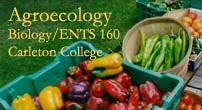
Farmelton
The Carleton Farm
A project of the Bio 160 Agroecology Course

College Name
Colorado College
Brief Description of College
It is a highly selective liberal arts college of about 2,000 students located in Colorado Springs, Colorado, on a 90 acre campus located in the historic part of town. The most unique feature of the college is the block plan, which means students take one course at a time for a period of three and a half weeks.
Farm Size
Three acres (a leased portion of a 200 acre farm located ten miles from campus)
Produce of Farm
Sunflowers, squashes, beans, corn, cutting flowers and pumpkins
They also raised pigs, goats, chickens, turkeys and horses.
Farming Approach
“As organic and sustainable as possible” This meant they used horses and humans to plow and for other labor, drip tape for irrigation, and lots of compost.
Where Produce Goes
Farmers’ Market
How Farm is Funded
A venture grant and a Donner Fund at Pikes Peak Community Foundation grant
How Farm is Staffed and Supervised
Student internships, with faculty supervisors
Note that the farm may not be running during the school year, since this information is not available at this time
Purposes of Farm
The farm is intended to be a place for academic studies, both in independent research and use in courses, and opportunities for community engagement. One example of the community engagement aspects of the farm is the creation of themed gardens for children, like a rainbow garden and a pizza garden.
How Farm was Initiated
One student was interested in creating an agroecology major, and spoke to a professor of environmental science about the possibility. This professor and another alum, former CC professor and current executive director of Pikes Peak Community Foundation, started to consider a small farm. With several students, they initiated a Farm Feasibility Research project, which took the form of a combined farm work and planning summer internship for the students.
Other Information
Class projects completed on the farm
Soil studies to research nutrient cycling,; potential for generating methane from animal waste; composition of plant communities in response to grazing; plant diseases and pests; light and temperature distribution in the traditional corn-bean-squash intercropping system
